Hair Breakage-Causes, How to Stop, Repair & Prevention
Hair breakage can be such a bloodcurdling experience for most individuals. This especially extremely frustrating for ladies who have been making efforts to grow natural, healthy, strong and longer hair. This article covers what hair breakage or falling out means, causes and how to stop, repair and prevent severe with worst and best treatment products and home remedies.
What is Hair Breakage?
Hair breakage is the shattering and snapping of hair strands caused by various external forces and poor care making the hair strand shorter than it was before. It is not a natural process but rather happens when the hair can no longer stand the pressure exerted on it.
In reality, the strength as well as elasticity of your hair comes from the presence of strong chemical bonds also known as disulphide bonds. These are extremely strong bonds that play a vital role in holding keratin protein within the hair cortex together.
The strength of hair is also dependent on the moisture content. Moisture enables the disulphide bonds present in your hair to retract and stretch to normal time and again. In the absence of disulphide bonds, your hair would break every time you comb it.
Hair falling out occurs only when the elasticity and strength of your hair is not at its optimum level. This happens primarily due to chemical processing like the use of highlighting, bleaching, keratin straightening treatment and a generous use of various heated styling. Details coming up shortly.
Hair Breakage or Shedding? What are the differences?
Hair breakage and hair shedding are forms of hair loss that are often confused. In fact, some use breakage and shedding interchangeably. Well, all of them imply hair falling out/off but the mechanisms behind are exactly not the same. Grasping how they differ is an important part of any healthy hair course of therapy especially if your ultimate goal is to excellently address even the smallest of your hair necessities.
Shedding is a form of natural loss. shed hair is hair that has reached the end of its growing cycle and naturally falls from the scalp
It is a normal part of the hair growth life cycle. Once your hair has final phase of the growth cycle its sheds. According to North American Hair Research Society (NAHR), the final stage, the actual shedding, is called exogen.
Below is an illustration by Viviscal show the stages.
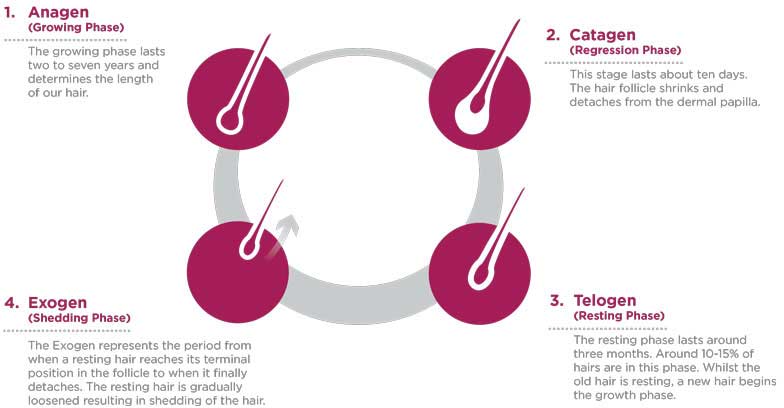
There is not much you can do about hair shedding and it should not worry you because it is a normal natural process. However, seek immediate medical attention if it is severe or comes along with a certain illness. There are other factors that can increase the rate at which your mane is shedding including, illness, pregnancy, genes and some medications.
Breakage on the other hand is not natural. As mentioned earlier, it comes as a result of what you do to your hair. That is, external forces and poor hair care routine. There’s of course something you can do to minimize it. Though this is debatable, it can be said that breakage is somehow natural or normal. This is particularly true in aged tresses that tend to break or split as a result of wear and tear.
Shedding happens from the hair root while breakage is usually far from the root. How do you tell if it is from the root? Examine the hair strand end. If there is a whitish bulb, then that is definitely from the root: the base of the hair strand found on the scalp. What this therefore implies is that hair shedding comes with white bulbs while hair breakage comes with none. This is at least very clear for black hair.
How much is considered as normal Hair Breakage?
Owing to the fact that there are different types of hair, the amount varies from one hair type to another or at least person to person. According to hair experts, losing few strands isn’t a problem. It is normal. But hair that is consistently breaking in large amounts is sign that there is something wrong.
Fact: No matter how cautious, soft or tender with your tresses, a few strands will have to fall out. You can as well have hair breakage accidently. It does happen. You aim should be to reduce and prevent the chances of breakage.
Who does locks breakage affect most?
African-American hair is affected compared to other races. According to a 2007 study published in Journal of Investigative Dermatology, this is due to the dry nature their hair in addition to various styling and hair care practices that weaken hair shaft. Additionally, hair of black women tends to be naturally curly hence requiring lots of detangling which will eventually lead to breaking.
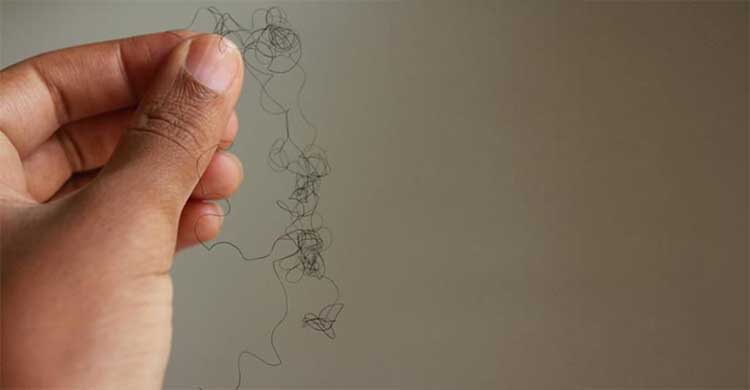
How to Stop Hair Breakage -Causes + Solutions
Hair is considered the pillar of beauty that is why hair care products are widely manufactured in the industry today. Everybody, be it men or women loves to have healthy, shiny and strong hair that reflects one’s personality. The following are some of the bad habits that can damage your hair and they include:
Inappropriate Hair Styles and Styling Tools
Blow dryers
The use of different styling tools for example blow dryer causes significant damage to your hair because the heat from the dryer strips the serum from your hair making it look dry and dull. To reduce damage on your locks, you should set your hair dryer on a low setting and constantly move it in up and down motions.
A 2011 study published in the Annals of Dermatology reports that using a hair dryer causes more surface damage than natural drying. When using a dryer you can use it at a distance of 15cm with continuous motion which causes relatively less damage.
Other styling treatments like straightening and curling contribute to more hair loss when done frequently.
Fix
When using a hair straightener or curler to style your hair, you should use less heat to avoid hair breakage. Minimize the frequency of use.
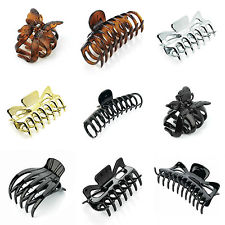
Hair Claws/Clamps/Clips
This are tools used to hold hair. These tools can lead to hair falling not only when used inappropriately but also when used correctly.
Fix
Of course the best way is to avoid these hair holding tools if you can. If you must use them, make sure to evenly separate your hair before sectioning. This will help reduce occurrence of pesky crosshairs.
Heat Damage-Flat Irons etc.
This is one of the two major causes of afro hair breakage. With the use of flat irons, you will alter the basic structure of your hair by breaking the strong bonds in order to change its composition from curly to straight. The high temperatures used for this practice have the potential to greatly damage your hair, especially when the process is repeated too often.
Heat also causes mid-shaft splits which opens and results to hair breakage, it also leads to the issue of split ends widening.
Solution
Trims are the best way to end this problem. If you carry out this process ensure not to overdo it. Just once in a while.
Inappropriate Combs and Excessive Combing
Too much combing or doing it too roughly will make you lose hair through breakage. On the other hand, thin-tooth combs or combs with seams can tug on your hair and yield mechanical damage.
Fix
Choose your combs wisely: avoid thin-tooth and seamed combs. Be gentle when combing your hair. Combing your hair minute after minute is as well total disrespect for your hair…give it some freedom. It can handle itself.
Styling
Wearing tight hair styles
Some hairstyles for example tight ponytails, braids, knots and buns cause damage to your hair. This is because tight hair styles put excessive tension on the hair follicles, which can lead to hair breakage and even hair loss. This can also lead to traction alopecia a condition that permanently weakens the follicles and makes it impossible for hair to grow. Wearing weaves and extensions also have the same effect.
Teasing/backcombing
Reckless teasing or backcombing your hair is highly damaging as it tangles your hair. It can lead to split ends and hair breakage for months. While teasing you lifts up the cuticles which greatly damage the natural fibers of protein that constitute the cuticles. Also aggressive brushing or over brushing is also not recommended as it causes too much friction and makes your hair weak and brittle.
Pineappling
Pinappling hair is a hair styling technique that a significant number of ladies opt for before bed time. It is thought to protect hair as well as preserve styles like the wash and go. This technique also another source of tension for your hair which eventually leads to breaking.
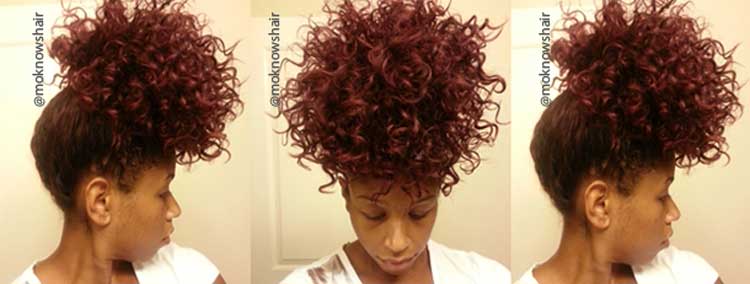
Banding
Hair banding is technique geared towards stretching your mane. Inasmuch as many think it is safe, it is actually a silent cause of hair breakage simply because, like many other hair styling techniques, it brings with it some form of force on hair.
Styling on wet or Drenched Hair
Hair is most fragile when wet or drenched with water. Styling the hair in this state may lead to mechanical breakage. Depending on the manipulation required for the desired style, it is better to wait until the hair is damp or damp-dry.
Fix: Stick to using your fingers to detangle while your hair is sopping wet to minimize breakage when hair is at its weakest.
Hair breakage after braids
Braids that are too tight can cause stress, which occurs when there is constant pulling on the hair follicles. Regular tensile stress can lead to serious hair loss conditions such as traction alopecia which is caused by wearing tight hair styles for a long period of time. Damage can occur due to the hair being weak and fragile.
When you wear twist on your hair by using braids the fine hair that is coily will wrap itself around other strands which when done manually can cause breakage along the hair shaft. This breakage is not readily apparent but as it continues the ends of the hair become sparse. Therefore braids can be done very loosely allowing your hair strands to remain in a clumped position.
Irregular Hair Trimming
If you hardly trim your split ends, then expect some of your hair to break at some point. Make sure to keep regular haircuts on your calendar for healthier, break-resistant hair.
Fix
Ensure to schedule regular haircuts on your calendar for break-resistant and healthier hair
Poor Diet-Protein, Zinc, Iron, and/or Vitamin E & B-12
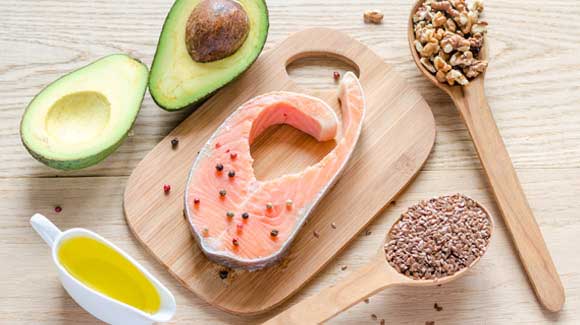
What you eat has a direct impact on your skin and hair health. Hair needs various vitamins, minerals and proteins to remain healthy. A 2002 study published in clinical and Experimental Dermatology highlights the relationship between nutritional factors and hair loss. The study shows the role of essential amino acids, protein, iron and serum zinc for hair growth.
A study published in the Journal of Korean Medical Science suggests that iron plays a certain role especially in premenopausal female pattern hair loss. Therefore in order to have healthy hair, you must include healthy and natural foods that are rich in protein, vitamin E /B-complex and iron in your diet. It is also important to include foods rich in trace minerals such as zinc and copper.
Taking a good multivitamin on a daily basis can ensure that you are receiving a sufficient amount of these nutrients. If you are severely deficient in zinc or iron (e.g., anemia), it is important that you check with your doctor.
Diet low in protein
Hair largely consists of protein that is keratin which is built from amino acids extracted from foods that are taken into your body. A diet low in proteins or lacks proteins or contains too many , proteins, oils and fats could well be a cause of natural hair breakage by weakening thinner hair strands and therefore causing hair breakage.
Your hair needs protein to stay strong. Protein can repair weak spots in the hair shaft, warding off breakage. But be
Note: Too much of anything is always not good for you general health. Excessive protein and other food supplements can make the hair brittle and unhealthy. It’s important to find the right balance that works.
Chemicals in Hair Care Products & Environment
Many people always rely on commercial shampoos, gels, serums and other hair styling products in order to keep their hair healthy. In real sense not all these products are healthy for your hair. Many of the products contain harmful chemicals that can cause great damage to your hair, which may not be reversible.
- Chemicals like hydrogen peroxide and ammonia found in hair dye can cause thinning hair and hair loss.
- Dihydrotestosterone or DHT is another harmful chemical found in shampoos that can contribute to hair loss.
- Hair breakage from relaxer: Chemical relaxers put stress especially on African-American hair while over-processing the hair shaft. In hair relaxers, the primary chemical of concern is sodium hydroxide, which can weaken the hair and cause a scalp infection. Relaxers chemically force curls and waves to become straighter, posing the risk of hair breakage and loss. Proper ethnic hair care is a must to keep the already fragile hair in good condtion.Treating hair loss caused by chemical relaxers is a discouraging experience but with a little patience your hair can be back to normal.
- Hair breakage from bleaching and color: Bleaching changes the structure of hair by penetrating the cuticle and removing pigment. Hair becomes weaker as a result of bleaching which can lead to breakage. Perms weaken hair by breaking and reforming inner bonds in hair.Permed hair, over time can become brittle and dry leading to breakage. This is due chemicals such as hydrogen peroxide and ammonia
Therefore you should stop overloading your hair with harsh chemical based products. Instead you should opt for herbal products and homemade recipes for hair masks or hair dyes that use or only contain natural ingredients.
Swimming in chlorinated water
Most people enjoy swimming. In addition to the enjoyment, as a physical activity, will help you stay physically fit and healthy.
But swimming in chlorinated water is not good for your hair. This is because chlorine builds up in the hair causing it to be frizzy and fragile. It can also remove the natural oil that covers hair shafts, which results in hair loss of shine and flexibility as well as making your hair more susceptible to breakage.
In a 2000 study published in the Journal of Dermatology, researchers examined 67 expert swimmers and 54 non-swimmers and found that 61percent of the swimmers exhibited symptoms of hair discoloration compared to non-swimmers.
If you like swimming, try to wear a swim cap and always make sure to shower and shampoo your hair immediately after swimming. Do not allow the pool water to dry up in your hair because it will damage your hair.
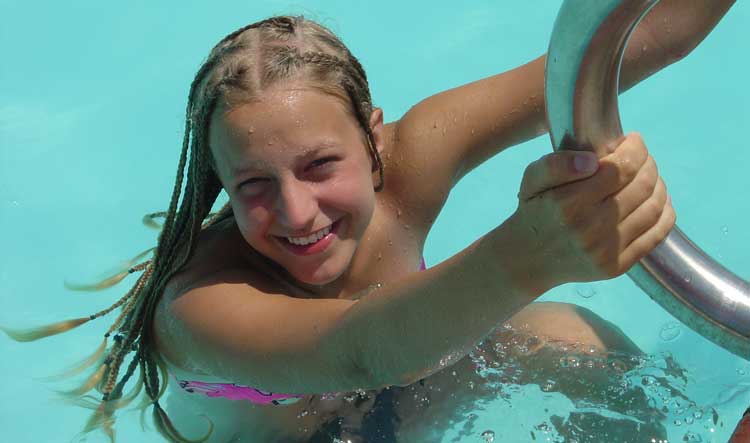
Hard Water/Mineral Build up
If you live in a place full of hard water, your hair will tend to accumulate minerals and as a result it will respond less to some products or at times you will see no improvement at all. This is because the minerals create something sort of a layer/deposit that covers the hair.
The accumulation is what others refer to as mineral build up. Some of these minerals that are found in hard water include, calcium, Sulphur among other metals. This often leads to breaking off of your hair.
Solution
Use a cleansing shampoo to remove the mineral deposits
Other Causes of Hair Breakage
Your Nails and Nail Extensions
Acrylics, not-evenly-filled, jagged and broken nail traps hair which leads to pulling and eventually breakage.
Ensure to get rid of the broken or jagged nails, find a protective material like gloves, evenly fill your nails or avoid detangling when you have acrylics on.
Stress
Stress not only affects one’s mental and physical health, it can as well cause hair loss. When you are under stress hair can go into the telogen phase (fall out).A 2003 study published in the American Journal of pathology states that hair follicles represent an important target for stressors.
Further, research has established that the effect of neurohormones, neuropeptides and neurotransmitters during stress may significantly influence the cyclic activity of hair follicles. Stress results to dermatologic problems in which hair loss is included.
Sleeping on a cotton pillowcase
Cotton can be both drying and abrasive to the hair. Sleeping on a satin/silk pillowcase can help prevent or stop hair breakage.
Overexposure to sun
Hair that has been overexposed during the summer months can be showing signs of weakness and breakage in the winter months.
Treatment. Depending on the extent of weakening, mitigation can range from regular deep conditioning of the hair with proteins to trimming for a fresh start. Also reduce the amount of time you spend under the sun. You can also an appropriate cap to cover your hair while under the sun.
Genetic factors
Due to its curly shape given by an oval shaped follicle, natural tresses face the risk of moisture not easily reaching its tip because of the shape, ripping the hair in the middle.
Hair breakage due to hormonal changes
Hormonal changes and imbalances can cause temporary hair loss. This could be due to pregnancy, childbirth or the onset on menopause. Hormone levels are also affected by the thyroid gland so thyroid problems may cause hair loss.
Weight loss
Hair breakage can sometimes be a temporary side effect of weight loss. When you lose more than 15 pounds, you may experience hair loss several months after you drop the weight regardless of the weight is lost. The health of your hair will eventually return to normal after a certain period of time.
Diseases
Diseases that can cause hair loss, thinning or breakage include:
- HIV(human immunodeficiency virus) infection
- Late stage syphilis
- Lupus, in which the hair tends to become brittle and may fall out in patches. Short, broken hairs commonly appear above the forehead. Hair loss is not usually permanent,
- Thyroid problems, which are common causes of scattered hair loss. Both an overactive thyroid (hyperthyroidism) and an underactive thyroid (hypothyroidism) can cause hair loss. Hair loss associated with thyroid disease can be reversed with proper treatment.
- Cancer, such as Hodgkin’s lymphoma.
- An adult form of muscular dystrophy (myotonic dystrophy).
- Diseases of the pituitary gland.
- Heavy metal poisoning, such as thallium or arsenic poisoning
- A disease that causes inflammation and scar tissue throughout the body (sarcoidosis).
- Any severe ongoing (chronic) illness.
Drug Side Effects
Hair loss can also be a side effect of certain medications including:
- Lithium
- Beta blockers
- Warfin
- Heparin
- Amphetamines and levodopa(Atamet,larodop,sinemet)
In addition, many medications used in cancer chemotherapy such as:
Doxorubicin (Adriamycin)-commonly cause sudden hair loss affecting the entire head.
Also;
- Arthritis
- Depression
- Heart problems
- High blood pressure and birth control drugs can cause hair loss
Hair Breakage at the Crown, Root and Hairline of the Head
Hair Breakage at the Crown
Hair breakage at the crown can occur due to the following reasons:
Texture and curl pattern differentials: It is not uncommon to have a slightly different texture or curl pattern in the crown area of the head. This area naturally has a different moisture and handling requirements to ensure that it thrives. If your crown area is finer, oilier, or kinkier than the surrounding strands, you should customize your hair care at this area by giving it extra moisturizing and conditioning time.
When the crown area is itchy, you should avoid scratching the area recklessly as it can break the hair and lead to a tender scalp. Therefore one should massage the area with the pads of your fingers and get some moisture to the area.
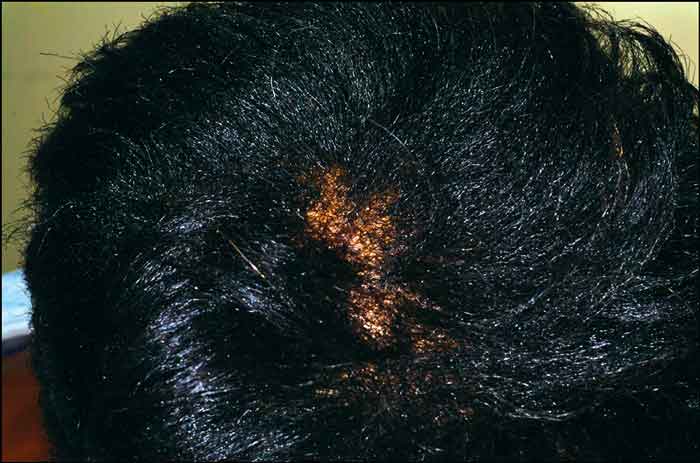
Improper/insufficient conditioning: Lack of proper conditioning is another cause of crown area failure because the crown area is the most exposed area of the head to the environment and other elements.
Physical trauma: Physical trauma culprits for crown area hair breakage include styling stressors like:
- Sew ins, braids and other weaves done too tightly picking out and softening the hair with hair tools e.g. combs
- Overlapping during 4-quadrant chemical services (relaxing, texturizing or coloring)
- High pressure shower water.
Opt for straight and free-form styles that are known to be good for maintaining hair. They include;
- Braid-outs,
- Twist-outs,
- Two strand twists
- Roller sets with minimal tangles
Puffs can also work, but they may stress the edges and hairline if not drawn properly.
Causes of hair breakage at the roots
As mentioned earlier, it is hair shedding that mostly happens from the root. However it is also thought that hair can break from the root because of;
Dry or chemically damaged hair: When your hair is lacking the oils and moisture it needs to thrive, it becomes damaged and breaks off easily. Dry, weather conditions and certain hair care tools can damage the strand, creating the appearance of frizzy hair which easily breaks off.
Your dietary habits reflect upon your hair. For example, food items that are rich in sodium can cause your hair to shed and break. Also sugary products tend to interfere with protein absorption so this could be the reason why your hair is breaking at the roots.
When you are not brushing properly: Many women tend to put much pressure on the hair while brushing. They also use plastic brushes that electrify the hair making it lose nutrients and oils. If you want to prevent hair breakage at the roots, you have to be very careful about your hair. Brush and style it carefully, offer it the nutrients and oils it needs and add to your diet super foods that promote good hair health.
Causes of hair breakage at the hairline
Tight hair styles such as braids, buns or pony tails put a lot of stress on the hair roots near the hairline as the hair is pulled away from the scalp. This causes damage to the hair follicles present in the area and prevent normal hair growth.
Those with curly hair suffer from hair loss after using hair relaxer excessively for relaxing their natural curls. Here; the damage is caused by harsh chemicals present in hair relaxer. Heat from hair dryers or curling irons can weaken the hair roots along the hairline and cause hair fall.
In some people, hair loss from the hairline can be due to pattern baldness. It is a hereditary condition where the hair roots become weaker after every growth cycle.
In women hair loss around the hairline can be due to hormonal imbalance triggered by pregnancy, birth control pills, menopause, thyroid problems and other problems. In these conditions, if the hormonal imbalance is associated with production of male hormones androgen, then the hairline area is particularly susceptible to breakage.
Physical and emotional stress: It can also affect the normal hair growth cycle. In normal condition barely 10 to 20 percent of the hair is resting stage, but the percentage may rise due to stress or health disorders. This is a temporary condition that creates receding hairline and is known as telogen effluvium.
Hair Breakage Treatment & Repair Products
Hair Breakage Repair and Best Treatment Products
The first anti breakage hair treatment is going for hair breakage treatment products available in the market. Some of the best hair breakage treatment products include:
Hair treatment conditioner: You should go for leave-in conditioners which will reduce breakages as you comb your hair. Some of the best conditioners to try including Matrix Sleek Look Conditioner.
Alternatively, you can use your regular conditioner but add about two teaspoons of olive oil and let it remain in your hair for about 5 minutes before washing it off and do this once a week.
Best shampoo for hair breakage: Shampoos can also be used as hair treatment products for breaking hair. There are quite a number of such products in the market which can be used for hair breakage. Going for products such as:
- Pantene Pro-V Anti-Breakage shampoo.
- Anti-Breakage shampoo
- John Frieda Root Awakening Health Infusing Shampoo and other best shampoo for hair breakage can help.
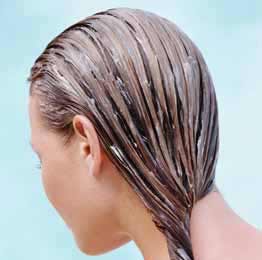
Protein Hair treatment: One of the hair breakage treatments at home you can try is the protein hair treatment. It is highly recommended for people whose hair is breaking at a high rate. You should try products such as Two-Step Protein Treatment which can be really good as an extreme hair breakage treatment and it will help people who are losing so much hair through breakages.
Over the counter medications: Some medications such as Retin-A and Rogaine are believed to help not only in stopping hair loss nut also work as a good treatment for hair breakage. However before you turn to over the counter medication it is good to know what actually is behind its breakage.
Products and Hair Styling Tools to Avoid
Hair breakage can be as a result of too harsh products that can leave your hair less and unhealthy. According to top stylists the worst hair products that should be avoided at all costs include the following:
Plastic brushes: According to Caroline Greyl president of Leonor Greyl, plastic brushes should not be used on your hair because they have a tendency to break the hairs. Instead you should try a pure boar bristle brush, like wigo cushion 100% boar bristle brush.
Cheap shampoo: According to Saviano, you should be careful when buying shampoo since some brands strip color and remove hair’s natural oils with high quantities of sulfates and other lathering ingredients. If you do choose a drugstore shampoo, look for one that is low in sulfates and contain moisturizing components.
Zinc pyrithione and coal Tar: These ingredients are the most common active properties in dandruff-fighting shampoos but Greyl warns that they can be incredibly harsh on the scalp and surrounding skin.
Salt sprays: Many salt sprays actually dry out your hair in the process of obtaining those crunchy waves which makes your hair dry leading to breakage.
Protein-Based conditioners: Conditioner fortified with protein is fine as long as it does not contain only protein but you should always use a combination of moisture and protein. Too much or only protein will make the hair lose its natural elasticity and will cause hair to snap while brushing and styling. Also overusing protein on hair can lead to straw-like strands especially on hair that is already damaged.
Silicone-based products: Silicone creates the illusion of healthy, shiny hair while actually further drying out the hair from the inside which is exactly unlucky as it sounds. Silicone coats the hair shaft for a smooth shiny finish but it prevents the real nutrients from conditioners to penetrate into the hair shaft.
Alcohol based products: According to Saviano you should avoid alcohol products which are mostly used in styling spray-gels because alcohol is a very drying ingredient for the hair. Alcohol products also trap moisture from the skin which makes the hair dry leading to breakage.
Fragnance: Fragnance is present in most deodorants shampoos, sunscreens, skin care, and body care and baby products. Many of the compounds in fragrance are carcinogenic or otherwise toxic. Fragnance on a label can indicate the presence of up to 4000 separate ingredients. Most or all of them are synthetic.
Clinical observation by medical doctors have shown that exposure to fragrances can affect the central nervous system, causing depression, hyperactivity, irritability, inability to cope and other behavioral changes which can lead to hair breakage.
Mineral oil and petrolatum: The best baby oil is made from almonds. But oil which is being sold as baby oil is 100% mineral oil. Mineral oil is a derivative of crude oil that is used industrially as a cutting fluid and lubricating oil. This commonly used ingredient coats the skin and hair just like plastic wrap.
Therefore the skin’s natural barrier is disrupted as this plastic coating inhibits its ability to breathe and absorb the natural moisture and nutrition. The skin’s ability to release toxins and wastes is also interfered with through the plastic wrap which can lead to acne and other disorders.
Home Remedies for Broken Tresses
Black tea to repair damaged hair: Tea is at the top list of home remedies for damaged hair. Tea can be used both internally and externally to restore shine, stop hair loss and stimulate healthy hair growth by eliminating dandruff, regulating the production of oil and preventing split ends.
Black tea is rich in antioxidants that repair chemically treated hair and protect the hair from sun damage. Other teas you can use as home remedies for damaged hair are: chamomile tea, peppermint tea, sage and rosemary.
Avocado treatment for dry hair due to straightening: Avocado is a great treat for home treatment for damaged hair. It is rich in vitamins, proteins, natural oils and essential fatty acids that dry damaged hair. It hydrates, softens and restores the natural elasticity of hair. Avocado and olive oil hair mask can also help fix damaged hair with split ends.
Olive oil remedy: Olive oil can also be used in damaged hair. It is easy to use and can be used in different recipes used in treatment for dry damaged hair. It is rich in vitamin E, antioxidants and fatty acids that seal in moisture and help to heal damaged hair and prevent further damage. Olive oil can also be used with egg, cucumber or yogurt to make a deep conditioning hair mask for dry damaged hair.

Aloe vera for split ends: Aloe vera is a plant that is rich in enzymes and has humectants properties making it an excellent remedy for treating dry damaged hair. It is also contains oils, amino acids and vitamin C and E. It deeply conditions to repair split ends and also gets rid of dandruff and other dry itchy scalp conditions.
Aloe vera can be used every time to you wash your hair or at least once a week for healthy hair. You can also use pure aloe vera gel by applying it directly onto hair for a deep hydrating feel.
Banana hair mask: Ripe bananas have deep conditioning and moisturizing properties that make it a great homemade conditioner for dry damaged hair. Bananas can be used as a base to make different hair masks that have many benefits for your hair.
Apple cider vinegar: Apple cider vinegar is a great treatment for hair. It has many benefits for hair that restore hair, leaving it soft, moisturized and shiny. It is a natural cleanser, clarifying hair conditioner that improves hair porosity and gets rid of tangles. It also balances PH, prevents split ends, treats dry itchy scalp and stops hair loss.
Beer for hair: Beer clarifies and conditions hair getting rid of build-up and repair damaged hair follicles and cuticles. The beer should go flat before using it on your hair.
Sandalwood oil: Essential oils such as sandalwood stimulate the sebaceous glands to produce more oil making hair feel softer and look shinier. Other essential oils that can be used for home treatment of dry hair that is getting damaged include:
- Clary sage
- Argan
- Rosemary
- Almond
- Lavender oils
For damaged bleached hair you can replace moisture and rejuvenate with rich nutrients that stimulate healthy hair growth and prevent hair fall. Some of the home remedies for damaged bleached hair include:
- Egg and milk
- Mayonnaise and avocado mask
How to Prevent Severe Hair Breakage
When your follicles have been damaged as a result of dry cuticles and using harsh chemicals, severe hair breakage is likely to follow up. Some of the symptoms that you should watch out include;
Hair feels gummy: When healthy hair is wet, it feels smooth and glossy. When damaged hair that is prone to breakage is wet, it can feel gummy or sticky to the touch. Individuals with a sticky-feeling hair should not dye or perm their hair, swim in chlorinated water or use styling products. Sticky, gummy hair will break if much more is done.
Hair dries slowly: Hair prone to breakage may not dry as quickly as hair that is healthy, due to lack of protein and moisture in the hair. Hair will try to retain moisture, making it stay wet longer. Even if, your hair takes longer to dry than usual, avoiding blow drying or using heat to prevent it from becoming more damaged. The healthiest way to maintain damaged hair is to avoid styling products and hair color until hair grows out completely.
Hair gets tangled easily: Hair prone to breakage may feel frayed easily and these coarse strands can get tangled more easily than hair that still contains sebum, the natural oil in hair. Although hair may become tangled, according to Kids Health it suggests that hair should be brushed when it is dry, because hair breaks easily when it is wet.
To avoid hair breakage while brushing or combing your hair, use a moisturizing conditioner after shampooing and spray with a detangler before brushing hair out when it is completely dry.
Hair elasticity: Hair breakage may occur in hair that is brittle when dry and stretchy when wet. To determine whether over processing has compromised the strength of your hair, pull a piece of hair from your scalp and submerge it in water.
After removing it from the water pull gently on each end of the hair. The hair will break, stretch or remain intact. If the hair breaks or stretches, it is unhealthy but if the hair remains intact it is said to be strong and healthy.
Now that you already understand the basics of hair breakage-causes and how to stop, treatment and repair options, fixing or preventing hair breakage should be a bit easier. You have no choice other than changing your hair care regimen. Watch the tools and products you use on your hair, check what you eat and choose the appropriate style. You can as well trim your hair for a fresh start.
Thanks for the information and tips. Using natural hair care products and food greatly affect in maintaining healthy hair.